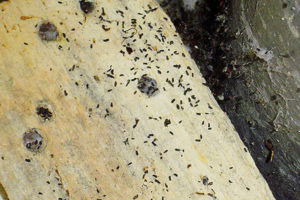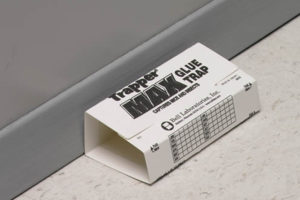Cockroaches
German Cockroaches
Description
Adult German cockroaches are 1/2 to 5/8 inch long and tan to light brown. Although they have fully developed wings, they do not fly. Nymphs are similar in appearance to adults except that they are smaller and lack wings. The German cockroach is best identified by its small size and by two dark parallel lines running from the back of the head to the wings. It is usually found in kitchens (near dishwashers, stoves, and sinks) and in bathrooms of homes.
German cockroaches usually prefer a moist environment with a relatively high degree of warmth. The insects are mostly scavengers and will feed on a wide variety of foods. They are especially fond of starches, sweets, grease, and meat products. In many locations, garbage is a principal food source. As with other species, German cockroaches are mostly active at night, when they forage for food, water, and mates. During the day they hide in cracks and crevices and other dark sites that provide a warm and humid environment. Their relatively wide, flat bodies enable them to move in and out of cracks and narrow openings with ease. They may be seen during the daytime, particularly if a heavy population is present or if there is some other stress, such as a lack of food or water or an application of pesticides.
Damage
German cockroaches produce odorous secretions that can affect the flavor of various foods. When cockroach populations are high, these secretions may result in a characteristic odor in the general region of the infestation. Disease-producing organisms such as bacteria, protozoans, and viruses have been found on cockroach bodies.
Different forms of gastroenteritis (food poisoning, dysentery, diarrhea, and other illnesses) appear to be the principal diseases transmitted by German cockroaches. The organisms causing these diseases are carried on the legs and bodies of cockroaches and are deposited on food and utensils as the cockroaches forage. Cockroach excrement and cast skins also contain a number of allergens to which many people exhibit allergic responses, such as skin rashes, watery eyes and sneezing, congestion of nasal passages, and asthma.
Management
Survey – To control German cockroaches, it is important to do a thorough inspection. A cockroach survey (trapping) is sometimes necessary to determine the extent of an infestation, as even a thorough inspection will not reveal all cockroach harborages or foraging areas.
Surveys involve placing sticky traps at strategic locations within the building. Whenever possible, place survey traps either against a wall or in a corner of the floor, a shelf, or a drawer, or under equipment and counters. Most commercially available traps come complete with bait to encourage cockroaches to enter. One week of trapping at a sufficient number of trapping sites (ten or more) usually provides enough information for effective control.
Sanitation, Structural Modification, and Repairs – It is difficult to keep cockroaches from entering homes via boxes, grocery bags, suitcases, and the like, but you can take steps to prevent a serious problem. A key factor in prevention is sanitation. Clean up all spilled foods, including crumbs on the floor. Do not leave dirty dishes overnight. Store items such as cereal, crackers, cookies, flour, sugar, and bread in airtight sealed containers. Empty garbage each evening into a sturdy container with a tightly fitted lid. Structural modifications such as caulking holes in walls where pipes pass through are necessary in the kitchen, bathroom, and other areas of the house in order to control German cockroaches.
Chemical Control – Baiting is an effective method to control or eliminate German cockroaches. Baits containing hydramethylnon, fipronil, sulfluramid, boric acid, or abamectin can provide a high level of control when applied to those areas where cockroaches harbor. Some formulations of baits are available to the public in plastic feeding stations. Professional pest control personnel also have cockroach baits in flowable granular and gel formulations. Care should be taken to closely follow the label instructions for use.
Insecticidal dusts like boric acid, silica aerogel, and diatomaceous earth can provide additional control. Apply dusts lightly, as heavy deposits may repel cockroaches. These products can be applied in the cracks and crevices of bureaus, clothes closet shelves, ceiling light fixtures, valances above windows, hollow legs of chairs and tables, and wall or floor cracks and crevices throughout the house. Do not place dusts where they could come in contact with children or pets. Do not allow children access to areas treated with boric acid. Boric acid is of low toxicity to adults, but it can present a hazard to children. Take precautions to assure that dusts do not contaminate food.
American Cockroaches
Description
The American cockroach is the largest of the species common to Pennsylvania. This species often becomes abundant in city dumps and is most common in the basements and steam tunnels of restaurants, bakeries, food-processing facilities, and grocery stores.
Adults are approximately 1-1/2 inches long and reddish brown, with fully developed wings that cover the entire length of the abdomen (Fig. 1). Both male and female are fully winged. The wings of the male extend slightly beyond the tip of the abdomen, while those of the female are about the same length as the abdomen. Nymphs are similar in appearance but are smaller and do not have wings. American cockroaches are capable of flying but rarely do in northern areas of the United States. The American cockroach can be identified by its large size and reddish brown color with faded yellow edges on the thorax.
When indoors, the nymphs and adults are usually found in dark, warm and moist areas of basements and crawl spaces, and in and around bathtubs, clothes hampers, floor drains, pipe chases, and sewers. They are also common around the manholes of sewers, and on the undersides of metal covers over large sump pumps. In the north, this cockroach is often associated with steam heat tunnels. Where steam heat tunnels are not found, the American cockroach is restricted primarily to large institutional buildings. It has also been observed migrating from one building to another during warm months in the north. Occasionally, the cockroaches infest sanitary landfills and can survive Pennsylvania winters because of the warmth generated within the piles of trash.
American cockroaches feed on a variety of foods, with an apparent preference for decaying organic matter. The adults can survive two or three months without food but only about a month without water.
Damage
American cockroaches feed upon a great variety of materials such as cheese, beer, leather, bakery products, starch in bookbindings, manuscripts, glue, hair, flakes of dried skin, dead animals, plant materials, soiled clothing, and glossy paper with starch sizing. The most important aspect of cockroach damage derives from the insects’ habit of feeding and harboring in damp and unsanitary places such as sewers, garbage disposals, kitchens, bathrooms, and indoor storage indoors. Filth from these sources is spread by cockroaches to food supplies, food preparation surfaces, dishes, utensils, and other surfaces. Cockroaches contaminate far more food than they are able to eat.
From various points in their bodies American cockroaches, and cockroaches in general, produce odorous secretions that can affect the flavor of various foods. When populations are high, these secretions may result in a characteristic odor in the general region of the infestation. Disease-producing organisms such as bacteria, protozoa, and viruses have been found in cockroach bodies. Different forms of gastroenteritis (food poisoning, dysentery, diarrhea, etc.) appear to be the principal diseases transmitted by these cockroaches. These disease-causing organisms are carried on the legs and bodies of cockroaches, and are deposited on food and utensils as cockroaches forage. Cockroach excrement and cast skins also contain a number of allergens, to which many people exhibit allergic responses such as skin rashes, watery eyes, congestion of nasal passages, asthma, and sneezing.
Management
Survey – To control American cockroaches, it is important to do a thorough inspection. A cockroach survey (trapping) is sometimes necessary to determine the extent of an infestation, as even a thorough inspection does not always reveal all cockroach harborages or foraging areas. Cockroach surveys involve placing sticky traps at strategic locations within the building. Whenever possible place survey traps either against a wall or in a corner of the floor, a shelf, a drawer, or under equipment and counters. Most commercially available traps come complete with bait to encourage cockroaches to enter. One week of trapping with a sufficient number of trapping sites usually provides enough information for effective control.
Sanitation, Structural Modifications, and Repairs – Modifying the interior environment—removing food, moisture, and harborages available to cockroaches—is the first step in treatment. Eliminating cockroach harborages involves caulking in closets and cabinets, caulking under the sink, etc., or making similar structural repairs in the kitchen, bathroom, and other areas of the house.
Cockroaches typically enter homes via boxes, grocery bags, suitcases, furniture, etc. To prevent the insects from establishing a breeding population, clean up all spilled food materials, including crumbs on the floor. Do not leave dirty dishes overnight. Store items such as cereal, crackers, cookies, flour, sugar, and bread in airtight containers.
Chemical Control – Dusts such as boric acid, silica aerogel, and diatomaceous earth can be applied to voids and other harborages such as cracks and crevices. Do not apply dusts to wet or damp areas. Dusts should be applied lightly because heavy deposits may repel cockroaches. Do not place dusts where children or pets could come into contact with them. Take care to keep children away from areas treated with boric acid. Take precautions to assure that the dusts do not contaminate food.
Baiting can be an effective method to control or eliminate American cockroaches. Baits containing hydramethylnon, fipronil, sulfluramid, boric acid, or abamectin should provide a high level of control when applied to those areas where cockroaches harbor. Care should be taken to closely follow the label instructions for use.
The use of residual sprays or aerosol foggers within a structure is of little value in controlling American cockroaches. In fact, these applications may disperse the cockroaches making control difficult and lengthy.
✓ Certified Technicians
✓ Extensive Industry Training
✓ Established in 1896
✓ Inspections
✓ Environmentally Conscious
✓ Full-Service Solutions
✓ FREE Consultations
✓ Maintenance Programs
✓ Rodent Exclusion
✓ Bed Bug Canine Inspections
✓ Guaranteed Satisfaction
✓ Emergency Service




